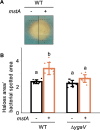Increased intracellular H2S levels enhance iron uptake in Escherichia coli
- PMID: 39324809
- PMCID: PMC11481527
- DOI: 10.1128/mbio.01991-24
Increased intracellular H2S levels enhance iron uptake in Escherichia coli
Abstract
We investigated the impact of intracellular hydrogen sulfide (H2S) hyperaccumulation on the transcriptome of Escherichia coli. The wild-type (WT) strain overexpressing mstA, encoding 3-mercaptopyruvate sulfur transferase, produced significantly higher H2S levels than the control WT strain. The mstA-overexpressing strain exhibited increased resistance to antibiotics, supporting the prior hypothesis that intracellular H2S contributes to oxidative stress responses and antibiotic resistance. RNA-seq analysis revealed that over 1,000 genes were significantly upregulated or downregulated upon mstA overexpression. The upregulated genes encompassed those associated with iron uptake, including siderophore synthesis and iron import transporters. The mstA-overexpressing strain showed increased levels of intracellular iron content, indicating that H2S hyperaccumulation affects iron availability within cells. We found that the H2S-/supersulfide-responsive transcription factor YgaV is required for the upregulated expression of iron uptake genes in the mstA-overexpression conditions. These findings indicate that the expression of iron uptake genes is regulated by intracellular H2S, which is crucial for oxidative stress responses and antibiotic resistance in E. coli.
Importance: H2S is recognized as a second messenger in bacteria, playing a vital role in diverse intracellular and extracellular activities, including oxidative stress responses and antibiotic resistance. Both H2S and iron serve as essential signaling molecules for gut bacteria. However, the intricate intracellular coordination between them, governing bacterial physiology, remains poorly understood. This study unveils a close relationship between intracellular H2S accumulation and iron uptake activity, a relationship critical for antibiotic resistance. We present additional evidence expanding the role of intracellular H2S synthesis in bacterial physiology.
Keywords: Escherichia coli; YgaV; hydrogen sulfide; persulfide; reactive sulfur species; supersulfide.
Conflict of interest statement
The authors declare no conflict of interest.
Figures







Similar articles
-
Mechanism of H2S-mediated protection against oxidative stress in Escherichia coli.Proc Natl Acad Sci U S A. 2017 Jun 6;114(23):6022-6027. doi: 10.1073/pnas.1703576114. Epub 2017 May 22. Proc Natl Acad Sci U S A. 2017. PMID: 28533366 Free PMC article.
-
Transcription factor YcjW controls the emergency H2S production in E. coli.Nat Commun. 2019 Jun 28;10(1):2868. doi: 10.1038/s41467-019-10785-x. Nat Commun. 2019. PMID: 31253770 Free PMC article.
-
Generation of hydrogen sulfide from sulfur assimilation in Escherichia coli.J Gen Appl Microbiol. 2019 Dec 19;65(5):234-239. doi: 10.2323/jgam.2018.11.001. Epub 2019 Mar 15. J Gen Appl Microbiol. 2019. PMID: 30880290
-
Enzymology of H2S biogenesis, decay and signaling.Antioxid Redox Signal. 2014 Feb 10;20(5):770-82. doi: 10.1089/ars.2013.5339. Epub 2013 Jun 7. Antioxid Redox Signal. 2014. PMID: 23600844 Free PMC article. Review.
-
Hydrogen polysulfide (H2S n ) signaling along with hydrogen sulfide (H2S) and nitric oxide (NO).J Neural Transm (Vienna). 2016 Nov;123(11):1235-1245. doi: 10.1007/s00702-016-1600-z. Epub 2016 Aug 2. J Neural Transm (Vienna). 2016. PMID: 27484215 Review.
Cited by
-
Heme bound to the bacterial transcription factor SqrR/YgaV catalyzes oxygen-dependent conversion of hydrogen sulfide to polysulfide for regulated gene expression.Redox Biol. 2025 Jul 31;86:103801. doi: 10.1016/j.redox.2025.103801. Online ahead of print. Redox Biol. 2025. PMID: 40763654 Free PMC article.
-
Sulfide-Responsive Transcription Control in Escherichia coli.Microorganisms. 2025 Feb 5;13(2):344. doi: 10.3390/microorganisms13020344. Microorganisms. 2025. PMID: 40005711 Free PMC article.
References
-
- Nishida M, Sawa T, Kitajima N, Ono K, Inoue H, Ihara H, Motohashi H, Yamamoto M, Suematsu M, Kurose H, van der Vliet A, Freeman BA, Shibata T, Uchida K, Kumagai Y, Akaike T. 2012. Hydrogen sulfide anion regulates redox signaling via electrophile sulfhydration. Nat Chem Biol 8:714–724. doi:10.1038/nchembio.1018 - DOI - PMC - PubMed
-
- Ono K, Akaike T, Sawa T, Kumagai Y, Wink DA, Tantillo DJ, Hobbs AJ, Nagy P, Xian M, Lin J, Fukuto JM. 2014. Redox chemistry and chemical biology of H2S, hydropersulfides, and derived species: implications of their possible biological activity and utility. Free Rad Biol Med 77:82–94. doi:10.1016/j.freeradbiomed.2014.09.007 - DOI - PMC - PubMed
-
- Mironov A, Seregina T, Nagornykh M, Luhachack LG, Korolkova N, Lopes LE, Kotova V, Zavilgelsky G, Shakulov R, Shatalin K, Nudler E. 2017. Mechanism of H2S-mediated protection against oxidative stress in Escherichia coli. Proc Natl Acad Sci U S A 114:6022–6027. doi:10.1073/pnas.1703576114 - DOI - PMC - PubMed
MeSH terms
Substances
Grants and funding
LinkOut - more resources
Full Text Sources
Medical
Molecular Biology Databases
